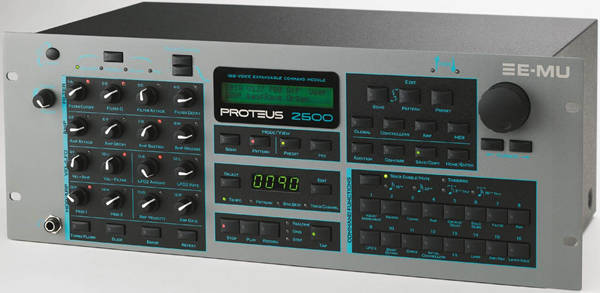Proteus 2500
Command Module

Overview E-mu Systems quickly repackaged the excellent MP -7/XL-7 design into a 4U rack unit to boost sales volumes in the Fall of 2001. Sampler sales were reducing and E-mu need to get a flagship product out. They kept the basic design of the desktop Command Stations, added a USB port for a super fast connection to a PC/Mac, and changed the color to a subdued silver with blue writing. Launched on October 8th 2001, they were quickly available in November.
The Proteus 2500 is based on the original Proteus 2000 sound module but with improved 24-bit DAC's from the XL-7/MP-7 Command Stations, and a new faster processor to cope with the sequencer addition and to improve MIDI timing with all 128 voices active.
Features The same 128 voices, up to 128 MB of sound ROM, a SP/DIF digital output, two MIDI outs, plus:
- 16 control knobs (can control external MIDI)
- 16 command function keys
- Sequencer Transport buttons
- 16 track Sequencer
- One LCD display and one 4-digit LED display
- Trigger key
- 4U Rack Mount

Expansion The Proteus 2500 has 3 ROM slots free for expansion. Each slot can take a 16 or 32 MB ROM, either a factory sound set or a Flash ROM with sounds created in an Emulator Ultra.
Sequencer The Command Station comes loaded with a 16 track sequencer, which can be controlled in grid, step or real time. There is a sophisticated song mode that allows you to chain patterns in a cue list, and dedicated Mute/ Select buttons that allow you to bring parts in "on the fly." This feature is perfect for remixing. The MP-7 features a large pallet of editing tools including cut, copy, paste, quantize, swing, and many more.
Filters The Command Station has 50 Z-plane 14-pole digital filters some of which are extracted from the 197 filter types that were created for the Morpheus. Some are rather newer (e.g. a TB303 emulation !) There are a wide range of filters from traditional analog, to formants and flange/phaser.
Configuration There are four "oscillators" called Instruments, Layers 1 - 4. They each can replay any of the 16-bit sampled waveforms, which are connected to the Z-plane filter, and then a digitally controlled amplifier(DCA) and stereo pan.
There are 2 envelope generators (one for the filter, and one for the DCA), plus a third assignable envelope generator. There are also two independent LFO's per layer, each with 17 different waveforms and they can sync to MIDI clock. Then there is a full modular patch cord facility to enable control of any of the 64 destinations, with any of the 64 sources.
Effects The usual dual 24-bit effects set up is included, with 76 types of basic effects. Rather long in the tooth, but useful nevertheless - not a substitute for a dedicated unit.
Verdict The Proteus 2500 . Well worth buying !
Diagnostics To enter diagnostics mode, power on with both cursor keys held down. There are 19 modes, which test out all the various components inside the Proteus 2500. To reinitialize and ERASE all user data, select Diagnostic 18 and press enter. Kapow!
Factory Demos
Demo Sequence Press and hold the Master and Edit buttons together to play the song demo's.
OS Updates
The Proteus 2500 runs the Command Station OS, which has been updated:
- OS 1.31
Upgrades
- Various Sound ROM's
- Latest OS
Sound ROMs
 The new Proteus modules have space for additional sound ROM's and E-mu released a wide range of ROM's from 1999- 2001. Here is the definitive list.
The new Proteus modules have space for additional sound ROM's and E-mu released a wide range of ROM's from 1999- 2001. Here is the definitive list.
- Protozoa - Proteus 1,2,3
- Holy Grail Piano
- Techno Synth Construction Yard
- Definitive B3
- Orchestral Sessions
- Sounds of the ZR (Piano)
- World Expedition
- X-Lead
- Pure Phatt
- Siedlaczek Orchestra
- Beat Garden